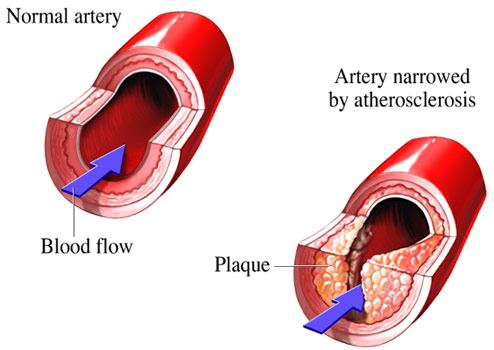Renal Artery Stenosis
The renal arteries are the main blood vessels that supply blood and oxygen to your kidneys. When these arteries become narrowed, it’s called renal artery stenosis (RAS). The narrowing is due to the buildup of plaque (atherosclerosis) inside the wall of the arteries. As plaque builds up, the walls of these arteries start thickening. This thickening leads to a reduced amount of blood flow to organs and tissues connected to these arteries. RAS reduces the flow of oxygen to the kidneys. This reduced blood flow in turn increases blood pressure in your whole body (systemic blood pressure) and injures kidney tissue.

Medical Illustration Copyright © 2019 Nucleus Medical Media, All rights reserved.
Causes of Renal Artery Stenosis
In most cases, atherosclerosis causes renal artery disease. However, other conditions, traits or habits may raise your risk for the disease. These conditions are known as risk factors and include:
Non-Modifiable Risk Factors: These factors are irreversible and cannot be changed. The more of these risk factors you have, the greater your chance of developing RAS.
- Older age
Modifiable Risk Factors: These factors can be modified, treated or controlled through medications or lifestyle changes.
- Diabetes: When your blood glucose, also called blood sugar, is too high.
- Long history of cigarette smoking and/or drug abuse.
- High blood pressure
- High cholesterol
- High Triglycerides: A type of fat (lipid) found in your blood at elevated amounts.
Other conditions that contribute to the development of RAS:
- Fibromuscular dysplasia
- Elevated protein levels in the urine: this may be indicative of kidney disease.
Symptoms of Renal Artery Stenosis
Unfortunately, there aren’t any detectable symptoms specific to RAS. However, once the condition reaches an advanced state, some of these symptoms may appear:
- Decreased kidney function
- Fluid retention
- Heart murmur
- High blood pressure that begins before age 30 or after age 50.
- High blood pressure that begins suddenly or worsens without explanation.
- Swelling of organs or body tissues including rapid lung swelling causing shortness of breath.
Diagnosis of Renal Artery Stenosis
Often, RAS is diagnosed during an examination for another condition, such as high blood pressure. After your doctor performs a physical exam and looks at your medical records, the following diagnostic tests and procedures may take place:
- Angiogram
- Computed tomography (CT scan)
- Magnetic resonance imaging (MRI)
- Blood tests
- Urinalysis
- Ultrasound
Treatment of Renal Artery Stenosis
Treatment for RAS may involve lifestyle changes, medication or a procedure. Sometimes a combination of treatments is the best approach. Treatment options include:
Lifestyle Changes
- Avoid smoking.
- Avoid alcohol consumption.
- Exercise under the directions of your doctor.
- Decrease your alcohol or caffeinated beverage consumption.
- Eat a heart-healthy diet.
- If you’re overweight, talk to your doctor about weight-loss options.
- Manage stress.
- Make and keep appointments to see your doctor for routine check-ups and follow-up tests.
Medications
High blood pressure often can be successfully treated with medications. Finding the right medication or combination of medications may require time and patience. Some medications commonly used to treat high blood pressure associated with renal artery stenosis include:
- Heart rate medications will help regulate your heartbeat.
- Calcium channel blockers will help relax blood vessels and increase the supply of blood and oxygen to the heart while also reducing the heart's workload.
- Diuretics “water pills” will help reduce the amount of fluid retention in your body.
- Statins will help reduce the level of cholesterol in the blood.
Medical and Surgical Procedures
For certain people, a procedure may be recommended to restore blood flow through the renal artery and improve blood flow to the kidney. Procedures to treat renal artery stenosis may include:
